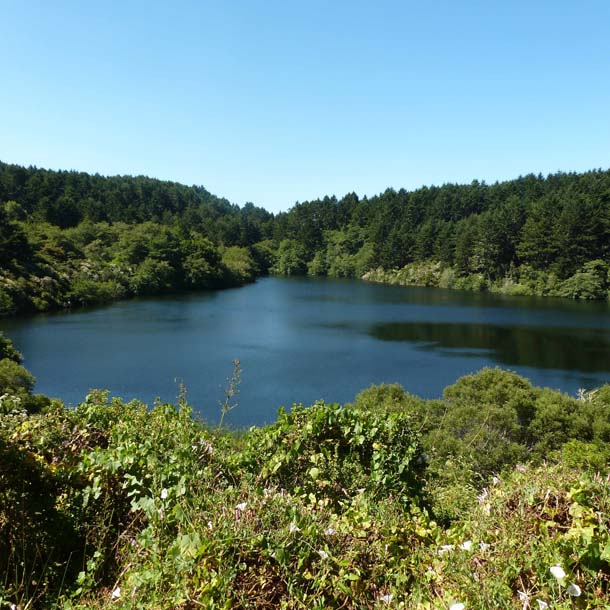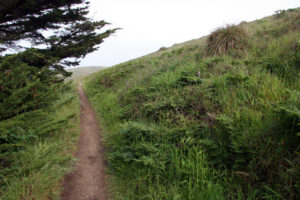Hiked on June 28, 2012. Calm, clear, and mild temperatures.
Walking is still the favorite sport, offering a shoulder to any bird, watching the sky in a puddle. –Kim Stafford in “A Thousand Friends of Rain.”
Last night, for the first time in their 132-year rivalry, the San Francisco Giants swept the L.A. Dodgers with a shutout. This morning my granddaughter, Kalia, took her first steps and the Supreme Court upheld “Obamacare.” To celebrate this abundance of good vibes, I decided to take a long “walkabout.” (My favorite definition of “walkabout” is the Australian: “a brief, informal leave from work, taken by an Aborigine to wander the bush, visit relatives, or return to native life.”)
At the Palomarin trailhead a sign warns “Entering Mountain Lion Habitat” and provides the usual cautionary notes–stand upright, maintain eye contact, back away slowly . . . If approached, be assertive, wave your arms, speak firmly or shout, throw sticks and rocks. It all sounds good on paper, but casts a slight pall over the first mile or two of the trail. Of course, one of the first things I notice on the trail is long string of fresh scat, composed mostly of hair, rather pungent, with pinched ends.

When planning my walkabout last fall I reviewed the records of mountain lion attacks on humans. From 1890 to 2007 there were a total of 14 attacks, six of which ended in death to the human involved–about one death every 20 years. Of course there have been numerous other non-lethal encounters in which there was no physical contact. Here’s my favorite from the California Department of Fish and Game website: “One incident involved a turkey hunter who was camouflaged and calling for turkeys when a mountain lion approached from behind. Immediately after the mountain lion confronted the hunter and realized that the hunter was not a turkey, the lion ran away. This is not judged to be an attack on a human.”
Also in California, there were 8 deaths by lightning in the 13 years from 1990-2003, or about one every one and a half years. So, it’s about 13 times more likely to be hit by lightning (especially if you play golf or climb mountains) than to be attacked by a puma. Nevertheless . . .
For the first mile or so, the trail parallels the cliffs above Palomarin Beach. Some raucous screeching in the sky catches my attention and I see two Peregrines wheeling and arcing over the beach, apparently harassing some circling vultures and ravens. Then I see the reason those carrion-eaters are circling–the deflated carcass of baleen whale at the water’s edge, hundreds of feet below. I’d heard that a rare fin whale had washed ashore somewhere on Point Reyes last week, and here it was. A close relative of blue whales and considered “endangered” under the US Endangered Species, fins are rarely seen inside the Continental shelf.


The Fin Whale sings in a voice as loud as a jet taking flight. To this thundering song, the rocks and bones reply. The great voice shakes of the sides of islands, rattles off the edges of continents, and is reflected off the darkened plain below. –Marine Mammals of the Pacific Coast, (2012, Allen, Mortenson, and Webb, U.C. Press, )
Farther along, a red-tailed hawk catches my attention as it launches off an outcropping that looks like what is called a “lion ledge” in some parts of the country.
Rounding a corner as the trail starts to wander away from the coast, at the bottom of a small sandstone scree, a cluster of magenta-pink flowers brightens the slope–it is the late-blooming and aptly named “farewell-to-spring.”
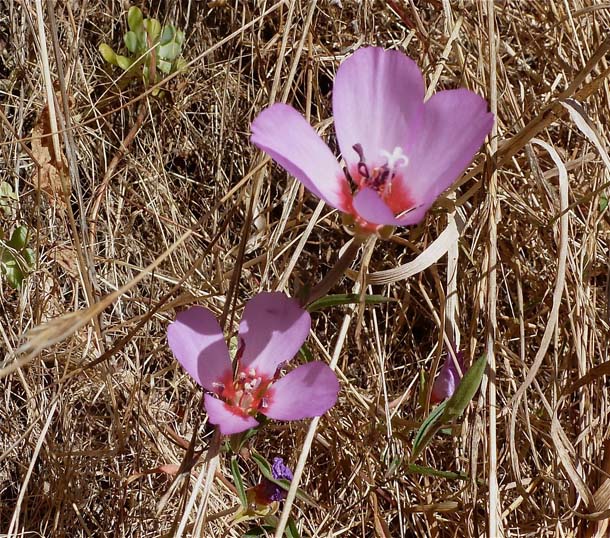
After passing through rather dry mixed northern coastal scrub and maritime chaparral the trail enters a damper fir forest and passes several discrete small lakes–actually “sag ponds” (see their geomorphology discussed in an earlier posting http://baynature.org/ptreyes-walkabout/walking-the-rift-zone-at-point-reyes) –before crossing a small bridge through an alder dell. Under the shade of the alders the temperature drops about 20°F and the trail follows the feeder creek to Bass Lake. On this warm and windless late morning dragonflies and damselflies are abundant, busy patrolling the trail for smaller insects.
The flight of butterflies today is impressive. Especially common were Satyr Anglewings and Pale Swallowtails.
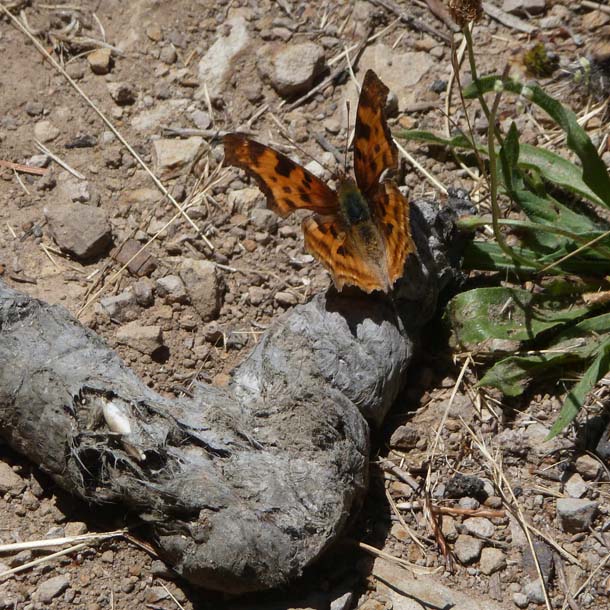
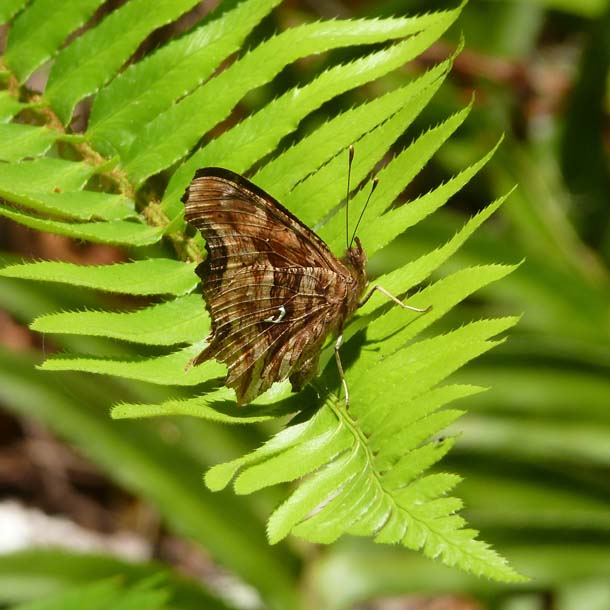
-

Bass Lake, looking west. One of several sag ponds that are accessed along this potion of the Coast Trail.
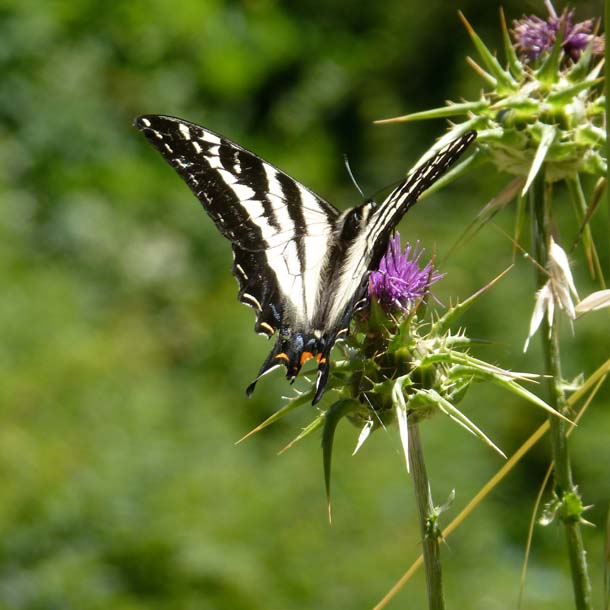
- Pale swallowtail (Papilo eurymedon). More reclusive and rural than the more familiar western tiger swallowtail, with narrower wings and muted color.
The most common birdsong along any section of this trail at this time of year is that of the deceptively plain-clothed Swainson’s Thrush. Its song is the emblematic sound of West Marin in summer, echoing through the forest and shrub from May through August. And what a sonorous song–a double helix of sound, spiraling skyward, always upward, in simultaneous and continuous chords of soprano and alto notes, unbroken, each measure playing off the other, finally trailing off into inaudible distances.
Here’s a link to the song. First listen to it as we hear it, then listen at slowed-down speed to hear the complexity and echoic quality of a sound that evolved to travel through tangled vegetation of the forest understory-and as other thrushes hear it.
“Ethereal” comes to mind as a word to describe the quality of the songs of the forest thrushes. They sing from dense cover and produces a hollow, doubled sound that spirals into the forest, weaving through boughs and brambles, rounding off the hard edges of needles and bark. These songs are so harmonized with the forest through which they travel that, like the memory of walking through those woods, one can not exist without the other. This echoic, hollow quality–all circumference, no center–and the syrinx and tympanic membranes that produce them, evolved in these forests, a means for the singer to speak to his neighbors or attract his mate without giving his location away to fox or hawk.
I reach the end of the trail late in the day, near dusk, when the thrush songs crescendo, the last sound from the forest before darkness falls. Robert Frost, the poet of my childhood, captured perfectly the flirtation of thrush song with that twilight moment in his poem “Come In,” from The Witness Tree (1942)
The last of the light of the sun
that died in the west
Still lived for one song more
in the thrush’s breast

- Swainson’s Thrush (Catharus ustulatus). Creative Commons photo by Minette Layne.
Critter List
Butterflies and Odonts
California Ringlet
Echo Blue
Ox-eyed Satyr
Pale Swallowtail
Red Admiral
Satyr Anglewing
Umber Skipper
Birds
Acorn Woodpecker
Allen’s Hummingbird
American Crow
American Goldfinch
American Robin
American White Pelican
Anna’s Hummingbird
Band-tailed Pigeon
Barn Swallow
Bewick’s Wren
Black-headed Grosbeak
Brandt’s Cormorant
Brewer’s Blackbird
Brown Creeper
Brown Pelican
Brown-headed Cowbird
Bushtit
California Quail
California Towhee
Caspian Tern
Chestnut-backed Chickadee
Cliff Swallow
Common Raven
Common Yellowthroat
Dark-eyed Junco
Downy Woodpecker
European Starling
Golden-crowned Kinglet
Hairy Woodpecker
Heermann’s Gull
Hermit Thrush
House Finch
Hutton’s Vireo
Lesser Goldfinch
MacGillivray’s Warbler
Mallard
Marsh Wren
Northern Flicker
Orange-crowned Warbler
Pacific-slope Flycatcher
Peregrine Falcon
Pileated Woodpecker
Pine Siskin
Purple Finch
Pygmy Nuthatch
Red-breasted Nuthatch
Red-shouldered Hawk
Red-tailed Hawk
Song Sparrow
Spotted Towhee
Steller’s Jay
Swainson’s Thrush
Tree Swallow
Turkey Vulture
Violet-green Swallow
Virginia Rail
Warbling Vireo
Western Gull
Western Scrub-Jay
Western Tanager
Western Wood-Pewee
White-crowned Sparrow
Wilson’s Warbler
Winter Wren
Wrentit
Mammals
Bobcat (scat)
Botta Pocket-Gopher (diggings)
Coyote (scat)
Dusky-footed Woodrat (nest)
Fin Whale (carcass)
Harbor Seal
Mountain Lion (scat)
Sonoma Chipmunk
Western Gray squirrel

